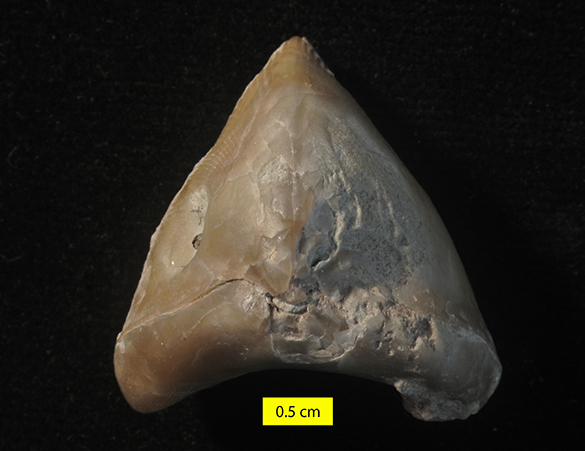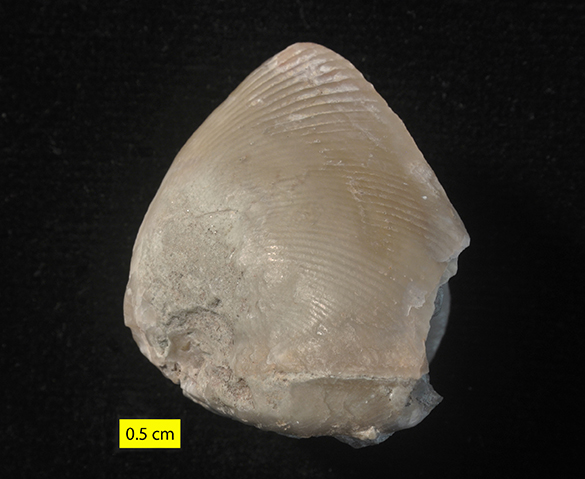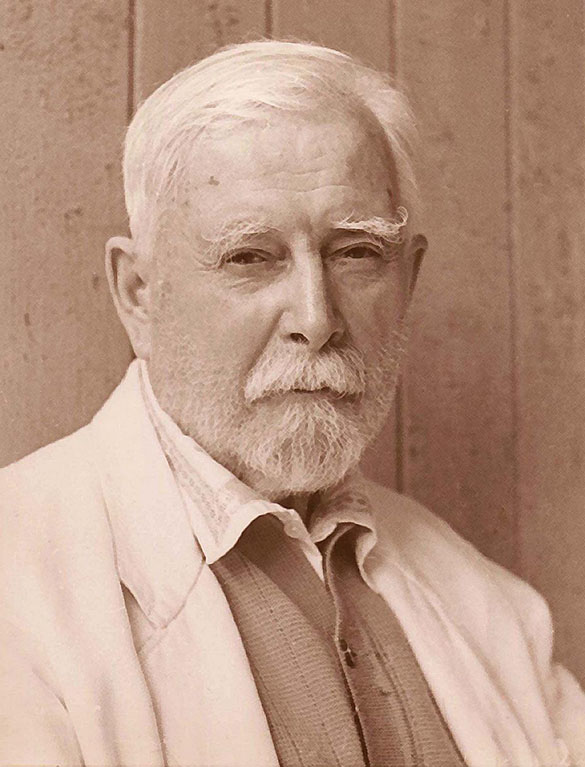 In the summer of 2009 I had a field adventure in Russia. It was an extraordinary time. I learned considerable amounts of Russian geology and paleontology, of course, and was immersed in the Russian geological culture. Along the way I collected the above unusual brachiopod. We are looking at its posterior (where the articulating hinge is), with the ventral valve below and dorsal valve above.
In the summer of 2009 I had a field adventure in Russia. It was an extraordinary time. I learned considerable amounts of Russian geology and paleontology, of course, and was immersed in the Russian geological culture. Along the way I collected the above unusual brachiopod. We are looking at its posterior (where the articulating hinge is), with the ventral valve below and dorsal valve above.
 This is the anterior view of the same specimen showing the junction between the valves (the commissure). The brachiopod is Ladogia Nalivkin, 1941, a rhynchonellid from the Upper Devonian (Frasnian) of the Central Devonian Field somewhere along the Syas River in the Leningrad Oblast of western Russia. We can immediately see that this brachiopod is very tall for its kind, with a strongly defined fold (the top part of the “anticline” in the dorsal valve) and sulcus (the lower folded surface in the ventral valve). Note that the sulcus has several encrusting organisms, including eroded microconchids.
This is the anterior view of the same specimen showing the junction between the valves (the commissure). The brachiopod is Ladogia Nalivkin, 1941, a rhynchonellid from the Upper Devonian (Frasnian) of the Central Devonian Field somewhere along the Syas River in the Leningrad Oblast of western Russia. We can immediately see that this brachiopod is very tall for its kind, with a strongly defined fold (the top part of the “anticline” in the dorsal valve) and sulcus (the lower folded surface in the ventral valve). Note that the sulcus has several encrusting organisms, including eroded microconchids.
 The side view shows the dramatic upward sweep of the dorsal valve and the fine radiating ornamentation. The tall fold was effective in separating the incoming water for filter-feeding from the outflow of filtered water, essentially functioning like a chimney. Many brachiopods have such a fold and sulcus, but few have a set of such amplitude.
The side view shows the dramatic upward sweep of the dorsal valve and the fine radiating ornamentation. The tall fold was effective in separating the incoming water for filter-feeding from the outflow of filtered water, essentially functioning like a chimney. Many brachiopods have such a fold and sulcus, but few have a set of such amplitude.
 Ladogia was described by Dmitrii Vasil’evich Nalivkin (1889-1982) in 1941. Nalivkin was a Soviet paleontologist and geologist born in 1889 in St. Petersburg. He graduated from the Institute of Mines in Petrograd (the name was changed from St. Petersburg) in 1915. In 1917 he joined the Geological Commission of Russia, staying a member through its many changes for over six decades. In 1920 he became a professor at the Institute of Mines after, we presume, the political situations from the Great War, the Bolshevik Revolution and the Russian Civil War calmed down. He is notable for giving the first lecture series on facies theory in the USSR in 1921. After World War II he was chairman of the Turkmen section of the Academy of Sciences. In 1954 he was made chairman of the Interdepartmental Stratigraphic Committee of the Academy of Sciences of the USSR. In 1954 he was appointed chairman of the Interdepartmental Stratigraphic Committee of the Academy of Sciences of the USSR. Nalivkin specialized in stratigraphy and paleontology of the Paleozoic, especially the Devonian and Carboniferous. He is best known for his geological maps of the USSR, for which he received the Lenin Prize in 1957. Here’s a man who saw a lot of history in his time.
Ladogia was described by Dmitrii Vasil’evich Nalivkin (1889-1982) in 1941. Nalivkin was a Soviet paleontologist and geologist born in 1889 in St. Petersburg. He graduated from the Institute of Mines in Petrograd (the name was changed from St. Petersburg) in 1915. In 1917 he joined the Geological Commission of Russia, staying a member through its many changes for over six decades. In 1920 he became a professor at the Institute of Mines after, we presume, the political situations from the Great War, the Bolshevik Revolution and the Russian Civil War calmed down. He is notable for giving the first lecture series on facies theory in the USSR in 1921. After World War II he was chairman of the Turkmen section of the Academy of Sciences. In 1954 he was made chairman of the Interdepartmental Stratigraphic Committee of the Academy of Sciences of the USSR. In 1954 he was appointed chairman of the Interdepartmental Stratigraphic Committee of the Academy of Sciences of the USSR. Nalivkin specialized in stratigraphy and paleontology of the Paleozoic, especially the Devonian and Carboniferous. He is best known for his geological maps of the USSR, for which he received the Lenin Prize in 1957. Here’s a man who saw a lot of history in his time.
References:
Nalivkin, D.V. 1941. Brachiopods of the Main Devonian field. Akademii Nauk SSSR Trudy 1: 139-226.
Sokiran, E.V. 2002. Frasnian-Famennian extinction and recovery of rhynchonellid brachiopods from the East European Platform. Acta Palaeontologica Polonica 47: 339-354.
Zhuravlev, A.V., Sokiran, E.V., Evdokimova, I.O., Dorofeeva, L.A., Rusetskaya, G.A. and Malkowski, K. 2006. Faunal and facies changes at the Early-Middle Frasnian boundary in the north-western East European Platform. Acta Palaeontologica Polonica 51: 747-758.


